INTRODUCTION
In 1948, the World Health Organization (WHO) proposed that health was more important than the absence of disease. More recently, the WHO Quality of Life Groups broadly stated that the subjective aspects of health depend on one's perception of one's own position in relation to the goals, hopes, standards, and concerns of the culture or value system within which one lives [
1]. As the standards of living have increased and the life-span extended, the meaning of health now translates to improving the quality of life.
Like other health conditions, oral health too affects individuals' quality of life [
2]. Oral health implies the standard of oral and related tissue health that enables individuals to eat, talk, and socially engage without illness or discomfort. Previous methods of measuring oral health primarily used clinical dental indicators and only focused on the presence of oral disease [
3]. Recently, as the concept of health has expanded beyond the absence of disease, quality-of-life measures have been developed to help assess the physical, mental, and social effects of oral health to quantify the extent to which oral disease interferes with daily life and well-being [
4].
As a measure of the quality of life related to oral health, Atchison and Dolan developed the Geriatric Oral Health Assessment Index in 1990 and Slade and Spencer developed the Oral Health Impact Profile (OHIP) in 1994 [
56]. Currently, the OHIP is the most frequently used measure of the OHRQoL. However, it has been suggested that the standard OHIP is unsuitable for children. Therefore, Broder developed the COHIP to measure the OHRQoL in children and adolescents [
2]. The final questionnaire consists of 34 items and 5 conceptually distinct subscales: oral health, functional well-being, social/emotional well-being, school environment, and self-image [
7]. The COHIP demonstrates good validity in measuring the OHRQoL [
8]. Moreover, a study examining the validity of the Korean version of the COHIP was conducted. The results showed excellent validity [
9]. However, few studies have measured the OHRQoL using the COHIP. Dental fear and anxiety are the main reasons for avoiding dental care [
10]. According to the 2006 National Oral Health Survey, 4 out of 10 people reported not visiting a dentist in the preceding year and 50% of the reasons cited pertained to fear and anxiety regarding dental treatment [
11]. Several studies examining dental fear reported that this was related to sex and age, and avoiding dental care because of dental fear was associated with poor oral health [
12131415].
Therefore, this study hypothesized that children with dental fear have poor oral health, affecting their OHRQoL. We aimed at examining the impact of dental fear on the OHRQoL by comparing the COHIP scores of middle school students with and without dental fear in Gyeonggi-do, South Korea.
Go to :

METHODS
1. Participants and study period
We used random selection to recruit middle school students in Gyeonggi-do for evaluating the relationship between dental fear and the OHRQoL in children and adolescents. Of the total 242 students (130 boys and 111 girls) invited to participate, 102 (49 boys and 53 girls) filled in questionnaires designed to evaluate dental fear and the OHRQoL in 2012 and 2014.
This study was approved by the Institutional Review Board (IRB) of Wonkwang University (WKIRB-201905-SB-036).
2. Methods and tools
Self-report questionnaires pertaining to dental fear and the OHRQoL were used. Dental fear was identified via “yes” or “no” responses to, “Have you ever been afraid of a dental visit?” The OHRQoL in children and adolescents was measured using the Korean version of the COHIP. It consists of 34 items, including 10, 6, 8, 4, and 6 on oral health, functional, social-emotional, school environment, and self-image items, respectively. Responses are provided using a scale as follows: 0 = never, 1 = almost never, 2 = sometimes, 3 = frequently, 4 = almost always. Scoring for 28 negative items is reversed, with higher scores representing positive OHRQoL; the overall COHIP score is calculated as the sum of the scores for all 34 items. The scores for the five subcategories are calculated as the sum of the scores for the items corresponding to each subscale.
3. Statistical analysis
The COHIP score is generally not considered to meet the assumption of normal distribution; the nonparametric analysis method is applied because the normality of the population cannot be assumed in normality tests. Regarding descriptive statistics, continuous variables are expressed as the mean and standard deviations. Cross-analysis was performed to assess differences in dental fear according to the sex. The COHIP scores were compared according to dental fear and the Mann-Whitney U test was performed. A Wilcoxon signed-rank test was performed to compare the COHIP scores reflecting dental fear changes between 2012 and 2014. A Kruskal-Wallis test was performed to compare COHIP scores for changes in dental fear by year. The Bonferroni correction was performed as a post-test. Overall, type I error level was set at 0.05 SPSS version 19.0 was used for statistical analyses (SPSS Inc., Chicago, Il, USA).
Go to :

RESULTS
The number of students reporting dental fear in 2014 declined from 2012, but the difference between years was non-significant (P > 0.05). In terms of sex-based differences within each year, women were more likely to report dental fear in 2012 and 2014. However, there was no statistically significant difference in dental fear according to the sex (
Table 1).
Table 1
Dental fear according to age and sex
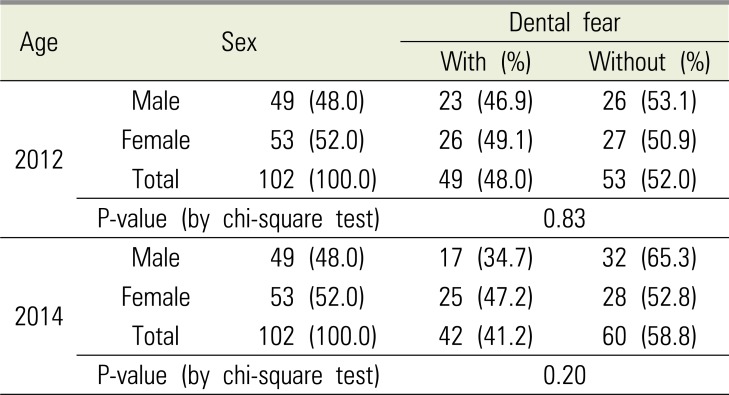
|
Age |
Sex |
Dental fear |
|
With (%) |
Without (%) |
|
2012 |
Male |
49 (48.0) |
23 (46.9) |
26 (53.1) |
|
Female |
53 (52.0) |
26 (49.1) |
27 (50.9) |
|
Total |
102 (100.0) |
49 (48.0) |
53 (52.0) |
|
P-value (by chi-square test) |
0.83 |
|
2014 |
Male |
49 (48.0) |
17 (34.7) |
32 (65.3) |
|
Female |
53 (52.0) |
25 (47.2) |
28 (52.8) |
|
Total |
102 (100.0) |
42 (41.2) |
60 (58.8) |
|
P-value (by chi-square test) |
0.20 |

In 2012, the group without dental fear showed higher COHIP scores than the group with dental fear. This difference was statistically significant (P < 0.05;
Table 2). However, in 2014, though the same pattern was observed, the difference was non-significant for all the COHIP items other than those pertaining to social-motional well-being (
Table 3).
Table 2
Differences in the COHIP scores between children with or without dental fear in 2012
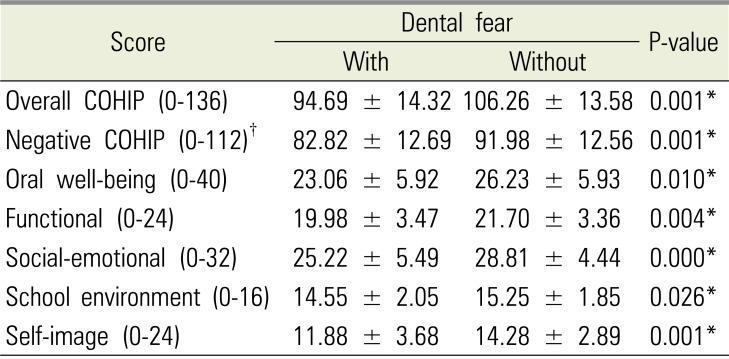
|
Score |
Dental fear |
P-value |
|
With |
Without |
|
Overall COHIP (0-136) |
94.69 ± 14.32 |
106.26 ± 13.58 |
0.001*
|
|
Negative COHIP (0-112)†
|
82.82 ± 12.69 |
91.98 ± 12.56 |
0.001*
|
|
Oral well-being (0-40) |
23.06 ± 5.92 |
26.23 ± 5.93 |
0.010*
|
|
Functional (0-24) |
19.98 ± 3.47 |
21.70 ± 3.36 |
0.004*
|
|
Social-emotional (0-32) |
25.22 ± 5.49 |
28.81 ± 4.44 |
0.000*
|
|
School environment (0-16) |
14.55 ± 2.05 |
15.25 ± 1.85 |
0.026*
|
|
Self-image (0-24) |
11.88 ± 3.68 |
14.28 ± 2.89 |
0.001*
|

Table 3
Differences in the COHIP scores between children with or without dental fear in 2014
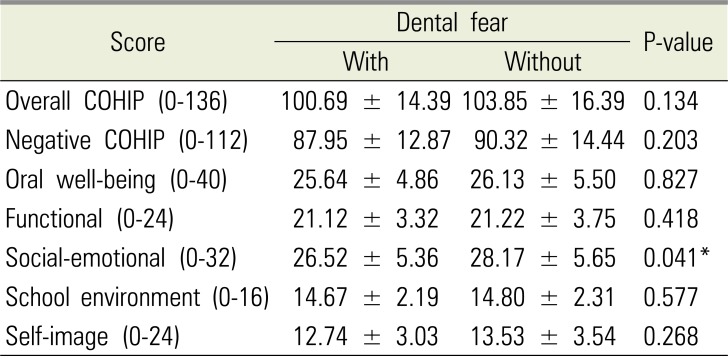
|
Score |
Dental fear |
P-value |
|
With |
Without |
|
Overall COHIP (0-136) |
100.69 ± 14.39 |
103.85 ± 16.39 |
0.134 |
|
Negative COHIP (0-112) |
87.95 ± 12.87 |
90.32 ± 14.44 |
0.203 |
|
Oral well-being (0-40) |
25.64 ± 4.86 |
26.13 ± 5.50 |
0.827 |
|
Functional (0-24) |
21.12 ± 3.32 |
21.22 ± 3.75 |
0.418 |
|
Social-emotional (0-32) |
26.52 ± 5.36 |
28.17 ± 5.65 |
0.041*
|
|
School environment (0-16) |
14.67 ± 2.19 |
14.80 ± 2.31 |
0.577 |

The analysis results regarding changes in dental fear showed that 63.8% of the participants' dental fear did not change over the 2 years, while that of 36.2% did. Sex-based differences dental fear were non-significant (
Table 4). Comparison of the COHIP scores reflecting changes in fear showed that the group with continuous dental fear showed significantly lower COHIP scores than the group without continuous fear for the overall COHIP, negative COHIP, and social-emotional wellbeing items in 2012 and 2014 (
Table 5).
Table 4
Changes in dental fear between 2012 and 2014
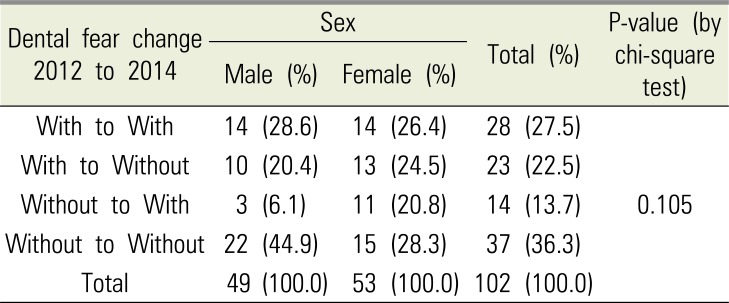
|
Dental fear change 2012 to 2014 |
Sex |
Total (%) |
P-value (by chi-square test) |
|
Male (%) |
Female (%) |
|
With to With |
14 (28.6) |
14 (26.4) |
28 (27.5) |
0.105 |
|
With to Without |
10 (20.4) |
13 (24.5) |
23 (22.5) |
|
Without to With |
3 (6.1) |
11 (20.8) |
14 (13.7) |
|
Without to Without |
22 (44.9) |
15 (28.3) |
37 (36.3) |
|
Total |
49 (100.0) |
53 (100.0) |
102 (100.0) |

Table 5
Changes in the COHIP scores according to changes in dental fear between 2012 and 2014
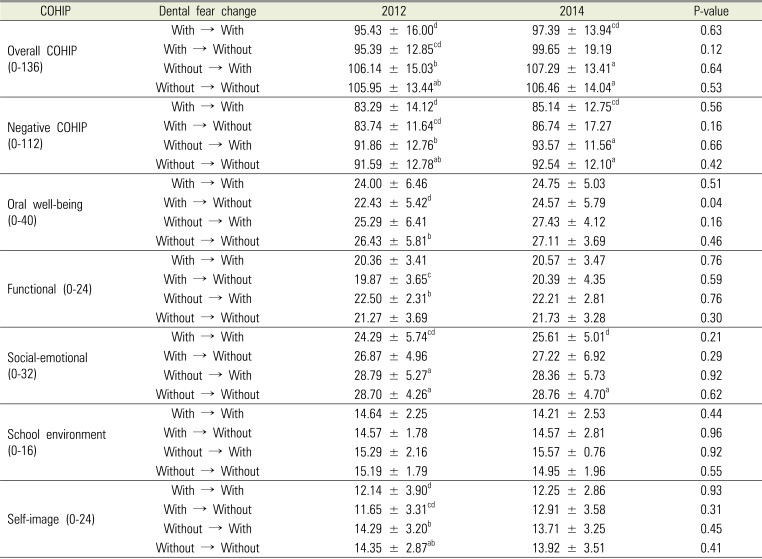
|
COHIP |
Dental fear change |
2012 |
2014 |
P-value |
|
Overall COHIP (0-136) |
With → With |
95.43 ± 16.00d
|
97.39 ± 13.94cd
|
0.63 |
|
With → Without |
95.39 ± 12.85cd
|
99.65 ± 19.19 |
0.12 |
|
Without → With |
106.14 ± 15.03b
|
107.29 ± 13.41a
|
0.64 |
|
Without → Without |
105.95 ± 13.44ab
|
106.46 ± 14.04a
|
0.53 |
|
Negative COHIP (0-112) |
With → With |
83.29 ± 14.12d
|
85.14 ± 12.75cd
|
0.56 |
|
With → Without |
83.74 ± 11.64cd
|
86.74 ± 17.27 |
0.16 |
|
Without → With |
91.86 ± 12.76b
|
93.57 ± 11.56a
|
0.66 |
|
Without → Without |
91.59 ± 12.78ab
|
92.54 ± 12.10a
|
0.42 |
|
Oral well-being (0-40) |
With → With |
24.00 ± 6.46 |
24.75 ± 5.03 |
0.51 |
|
With → Without |
22.43 ± 5.42d
|
24.57 ± 5.79 |
0.04 |
|
Without → With |
25.29 ± 6.41 |
27.43 ± 4.12 |
0.16 |
|
Without → Without |
26.43 ± 5.81b
|
27.11 ± 3.69 |
0.46 |
|
Functional (0-24) |
With → With |
20.36 ± 3.41 |
20.57 ± 3.47 |
0.76 |
|
With → Without |
19.87 ± 3.65c
|
20.39 ± 4.35 |
0.59 |
|
Without → With |
22.50 ± 2.31b
|
22.21 ± 2.81 |
0.76 |
|
Without → Without |
21.27 ± 3.69 |
21.73 ± 3.28 |
0.30 |
|
Social-emotional (0-32) |
With → With |
24.29 ± 5.74cd
|
25.61 ± 5.01d
|
0.21 |
|
With → Without |
26.87 ± 4.96 |
27.22 ± 6.92 |
0.29 |
|
Without → With |
28.79 ± 5.27a
|
28.36 ± 5.73 |
0.92 |
|
Without → Without |
28.70 ± 4.26a
|
28.76 ± 4.70a
|
0.62 |
|
School environment (0-16) |
With → With |
14.64 ± 2.25 |
14.21 ± 2.53 |
0.44 |
|
With → Without |
14.57 ± 1.78 |
14.57 ± 2.81 |
0.96 |
|
Without → With |
15.29 ± 2.16 |
15.57 ± 0.76 |
0.92 |
|
Without → Without |
15.19 ± 1.79 |
14.95 ± 1.96 |
0.55 |

Go to :

DISCUSSION
This study's results are meaningful in that the same questionnaire was administered to the same participants in 2012 and 2014 to examine changes in dental fear. Additionally, the exploration of associations between indicators of the OHRQoL and dental fear was important. Dental fear is often related to sex and age; it is reported more frequently in women than men and is inversely related to age. However, the apparent associations between dental fear and sex and age are neither consistent nor universal [
13].
In this study, the number of respondents who reported dental fear declined, from 48% in 2012 to 41.2% in 2014. However, this result was non-significant. In previous studies examining the association between dental fear and age, Holtzman et al. [
13] showed dental fear to be inversely proportionate to age; Berggren and Meynert [
14] reported that younger patients showed higher fear levels than older patients. Moreover, Klingberg et al. [
15] posited that age was an important cause of dental fear in a study of 3,204 children aged 4–11 years. This suggests that the younger the children, the more likely they are to find the dental environment threatening. Dental fear generally begins in childhood and is attributed to the trauma of previous dental experiences [
14]. With age, dental fear and anxiety decrease and are rarely problematic among adults, if handled correctly during childhood [
13].
Moreover, sex has often been associated with dental fear and anxiety, which are reported more frequently in women than men. Both Moore et al. [
16] and Schwarz and Birn [
17] observed dental fear and anxiety more frequently in women than men. In 2012 and 2014, the number of women with dental fear was higher than men, but this difference was non-significant. Like the results of this study, a study conducted by Locker and Liddell [
18] did not show any significant sex-related differences in dental fear. Further, Milgrom et al. [
19] did not observe any direct effect of the sex on dental fear. Peretz and Efrat [
12] suggested that high levels of dental fear in women were not absolute and could vary according to the stimulus. Moreover, the final factor involved in identifying high dental anxiety levels is personal temperament, the development of which is a continually conditioned process learned from responses to life's experiences [
12].
Dental fear and anxiety have been identified as important factors in delaying and avoiding dental care [
13]. Evidently, oral health is affected by dental fear and avoidance [
14]. This was confirmed in a study examining children's dental fear. Dental fear in children involves avoidance and more carious tooth surfaces [
15].
The OHRQoL has been studied in connection with a wide range of oral conditions, such as caries, malocclusion, cleft lip and palate. A systematic review study established the relationship between the clinical oral health status and OHRQoL in children [
4]. In a study evaluating the effectiveness of the Korean version of the COHIP, the overall COHIP score was significantly lower in children with caries and needing orthodontic treatment [
9]. Nevertheless, the direct relationship between the oral condition and OHRQoL is difficult to define. This is because it is mediated by personal, social, and environmental variables influencing the understanding of the relationships among health, illness, and quality of life [
4].
This study found that in 2012, the group with dental fear showed significantly lower COHIP scores than the group without dental fear. In 2014, though this still held true, this difference was non-significant for all items other than those pertaining to social-emotional well-being. There was no direct correlation between dental fear and the COHIP scores.
Our longitudinal questionnaire-based survey demonstrated changes in dental fear over time. No significant sex-based differences in dental fear was observed. However, it is noteworthy that the number of men within the group without dental fear, whose fear levels changed was very small than the women. The COHIP scores were compared to examine changes in dental fear. In both 2012 and 2014, the group with continuous dental fear showed lower overall COHIP, negative COHIP, and socialmotional well-being scores than the group without continuous dental fear.
It is difficult to generalize the results of this study because the study participants were limited to one middle school in Gyeonggi-do. Further, due to the nature of longitudinal studies, the number of study participants was small, and the survey period was limited to two years. The COHIP has proven to be an effective evaluation method for the OHRQoL, but there are few studies that have used it. In particular, longitudinal studies are rare. To improve the OHRQoL, further studies on the COHIP index and oral health conditions are needed.
While previous studies examining dental fear explored epidemiological factors, such as sex, age, and parental fear, the current study was meaningful in that it attempted an objective comparison between indicators of the OHRQoL. In conclusion, there was no direct relationship between dental fear and the OHRQoL.
Go to :










 PDF
PDF ePub
ePub Citation
Citation Print
Print



 XML Download
XML Download